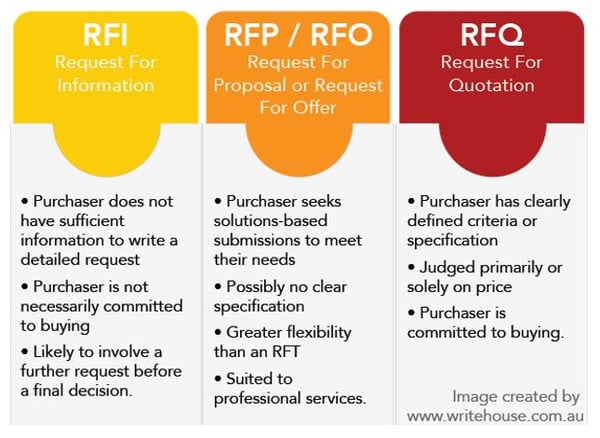It's a common mistake among procurement newbies to use the acronyms RFQ and RFP interchangeably. Throw in RFI, and things really start to get hairy. Understanding the nuances that distinguish these different types of requests (for information, proposal and quote) will help you get what you need a little faster and more easily, and that's something you simply can't argue.
.jpg?width=1360&name=stefan-stefancik-257625-unsplash%20(1).jpg) Photo by Štefan Štefančík on Unsplash
Photo by Štefan Štefančík on Unsplash
So, What's the Difference?
RFI
What it is: a request for information from prospective vendors
Use It When: You need more information before moving on to a more formal request. You have a huge list of prospective suppliers that you need to whittle down to select the right one to manufacture your parts. So, you request information from each supplier to find out more about them, if they have the capabilities and experience to make your product and ultimately shorten your list of prospects. A request for information is usually the first step and will precede either an RFP or -Q.
Benefits: Collect information and gain clarity with no commitment to purchase
RFP
What it is: a request for proposals (to solve a problem)
Use it When: You have a problem and you need to solve it, but you're not sure you've arrived at the best solution. Essentially you're opening the floor to ideas from multiple parties. This type of request is typically a more formal, involved process than the other two.
Benefits: Multiple solutions/options to choose from, provided by a variety of vendors; ability to leverage competition amongst prospective suppliers
Program manager and digital marketing tech consultant Pramod Rao suggests that an RFP include the following items:
- Requirements (business, technical, operational, security, compliance, legal, quality requirements, etc.)
- Service Level Agreements
- Change Management Procedures
- Acceptance Criteria
- Pricing Models
- Evaluation Criteria
- Penalty
- Working Environment
Read More: A Guide to Writing a Request for Proposal by werc.org
RFQ
What it is: a request for a quote
Use it When: You know exactly what you want, but you need to know how much it will cost. A quote may include more information than cost alone (e.g., scheduling, additional criteria), but it's usually the final stage of requests before vendor selection. To compare pricing apples-to-apples, you must submit detailed specifications so each vendor can provide an accurate quote.
Benefits: Obtain cost information easily from multiple suppliers
Free Download: RFQ Checklist
Let's Look at Some Examples
Request for Information (RFI)
You're an entrepreneur with a brilliant product idea, and you're brand spankin' new to the manufacturing world. You have a solid idea of your product design, and now you're ready to move forward with tooling, sampling and production. But where do you begin?
This is the perfect scenario for sending information requests. Do some research, compile a list of vendors you think could handle the job, and send each one an RFI. You can request a fact sheet, company presentation or a call to learn more about the company. Armed with this information, you can adequately narrow down your list of possible partners.
Request for Proposals (RFP)
We'll stick with the idea that you're an entrepreneur, but this time you don't have a solid product design. Instead, you've simply identified a problem or complaint among consumers and wish to make a product to solve this problem, but you could use the input and expertise of established product developers and manufacturers to arrive at the best solution.
The best approach is to write a formal request for proposals (check out this guide to get started) and submit it to multiple vendors you identified as prospects through an RFI exercise. The document must clearly outline the problem, as well as any strict parameters and/or project expectations, along with a deadline for proposals. You'll then review each submission and choose the one that best aligns with your project.
Request for Quote (RFQ)
Sometimes an RFQ will follow a round of proposal requests but, more often than not, pricing is included in proposal submissions. A more likely scenario is that a request for quotation will follow the information requests. Once you've selected a handful of vendors that are qualified to manage your project, request quotations so you can compare the vendors side-by-side. This is typically the final stage of requests before moving forward with a partnership with your chosen vendor.
The image below, courtesy of www.writehouse.com.au, summarizes these three types of requests:
Summary
If you're new to procurement, the industry jargon could be a small hurdle, but learning the difference between each type of request is crucial to your purchasing strategy and vendor negotiations. With a few requests under your belt, you'll be a seasoned pro in no time.
Suggested Reading:





.jpg?width=176&height=56&name=MR_associatedNetwork_logo%20(1).jpg)